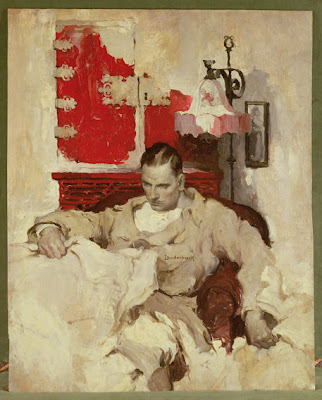This month marks the 136th anniversary of the Battle of Little Bighorn, or as the victors called it, the Battle of the Greasy Grass. On June 25, 1876, a sizable force of American Indians camped near the Little Bighorn River in eastern Montana met and crushed the United States Seventh Cavalry under George Armstrong Custer, killing him and 267 of his officers, men, and scouts. The popular image of the battle at Little Bighorn comes from a lithograph made by the German-American artist F. Otto Becker (1854-1945) and mass produced in 1896 by the Anheuser-Busch Company of St. Louis, Missouri. Becker's image, entitled "Custer's Last Fight," is justifiably famous. Lost and almost forgotten today is the work that preceded and inspired it. Also called "Custer's Last Fight," it was painted by Cassilly Adams, an Ohio artist laid to rest in an Indiana cemetery.
Cassilly Adams was born on July 18, 1843, in Zanesville, Ohio. His father was a Massachusetts-born lawyer, descended from President John Adams. As a young man, Cassilly Adams served in the United States Navy during the Civil War, first as a Master's Mate, then as an Acting Ensign in the Mississippi Squadron, aboard the U.S.S. Osage. He studied at the Boston Academy of Art and the Cincinnati Art School and made his living as a landscape artist, designer, and engraver. By 1880, Adams was living in St. Louis. In 1884-1885, he painted a monumental canvas--16 1/2 feet by 9 1/2 feet--depicting the Battle of Little Bighorn. (There were also two end panels depicting Custer as a small boy and in death.) The idea was for the painting to be a traveling exhibition and subject of a lecture for paying customers. That venture fell through, and the painting went to a St. Louis saloonkeeper, and, upon his death, to the Anheuser-Busch Company. Otto Becker was brought in to turn Adams' painting into a popular lithograph. In his book One for a Man, Two for a Horse, author Gerald Carson called Adams' work "the most popular exemplar of American saloon art." It was also used to sell patent medicine. Unfortunately, Cassilly Adams' original painting, "Custer's Last Fight," is no longer with us. Anheuser-Busch presented it to the Seventh Cavalry, which proceeded to lose it despite its immense size. The painting was rediscovered, lost again, found again, restored during the Great Depression, and finally put on display at the officer's club at Fort Bliss, Texas. On June 13, 1946, almost seventy years to the day after the Battle of Little Bighorn, the painting was destroyed by fire.
Little is known otherwise of Cassilly Adams. He worked in Cincinnati and Toledo as a designer and engraver and painted numerous scenes of Indian life. The 1920 census found him in Marion County, Indiana. At age seventy-seven, he was occupied as a farmer. He died the following year, on May 8, 1921, in Traders Point and--like Custer and his men--sought the high ground, for Cassilly Adams now lies buried at Crown Hill Cemetery, located at the highest point in Indianapolis.
 |
| An adaptation of Cassilly Adams' painting "Custer's Last Fight," here used to advertise M.A. Simmons Liver Medicine. The original painting is now lost. Images of it can be hard to find. |
 |
| Instead we have Otto Becker's lithograph, also adapted from Adams' original painting. This image, from 1896, is often attributed to Adams. Robert Taft discussed images of the battle in the pages of the Kansas Historical Quarterly in November 1946 (Vol. 14, No. 4) and in his book, Artists and Illustrators of the Old West: 1850-1900 (1953). You can read Taft's article and see other images on the website of the Kansas State Historical Society, here. |
 |
| Three images of Indian life by Cassilly Adams. |
 |
| Postscript (July 15, 2012): "Custer's Last Fight" by Cassilly Adams, an image from Dr. Robert Taft's Artists and Illustrators of the Old West: 1850-1900 (1953). This version is from a restoration made in 1938. I wonder if there is an extant image of the original painting or of its two flanking panels. |
Postscript (Feb. 5, 2015): Author Myron J. Smith, Jr., has cited this article in his new book, Civil War Biographies from the Western Waters: 956 Confederate and Union Naval and Military Personnel, Contractors, Politicians, Officials, Steamboat Pilots, and Others (Jefferson, NC: McFarland and Company, 2015). Mr. Smith has given an interesting account of Cassilly Adams' military career during the Civil War. You can see a preview of Mr. Smith's book on Google Books.
Text and captions copyright 2012, 2024 Terence E. Hanley

















































